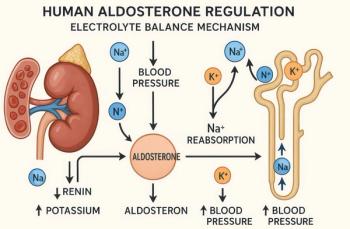
Pulse Pressure Linked to Atrial Fibrillation Risk
WALTHAM, Mass. -- Pulse pressure, the difference between systolic and diastolic pressures, may be a risk factor for the onset of atrial fibrillation independent of arterial pressure and other known factors, researchers said.
WALTHAM, Mass., Feb. 21 -- Pulse pressure, the difference between systolic and diastolic pressures, may be a risk factor for the onset of atrial fibrillation independent of arterial pressure and other previously recognized factors.
In an observational study, each 20 mm Hg increase in the difference between systolic and diastolic blood pressure was associated with a 24% increase in the risk of developing atrial fibrillation, even after adjusting for average arterial pressure and clinical risk factors, found Gary F. Mitchell, M.D., of Cardiovascular Engineering, of Waltham, and colleagues.
The findings, derived from the community-based Framingham Study, suggested that pulse pressure as a simple measure of arterial stiffness may represent a potentially modifiable risk factor, the investigators said in the Feb. 21 issue of the Journal of the American Medical Association.
They added, "lifestyle modifications or therapy aimed specifically at reducing or limiting the increase in pulse pressure with advancing age may markedly reduce the substantial and rapidly growing incidence of [atrial fibrillation] in our aging society."
Previous studies have identified advancing age, increased systolic blood pressure, diabetes, hypertension, heart failure, valvular disease, myocardial infarction, and obesity as key clinical risk factors for atrial fibrillation. Echocardiographic risk factors include left atrial enlargement, increased left ventricular wall thickness, and impaired left ventricular systolic function.
Because these factors may be related to aortic stiffness, the researchers analyzed the subset of 5,331 Framingham Study participants who were age 35 or older (mean about 57) and had never been diagnosed with atrial fibrillation. Dr. Mitchell, the lead author, owns a company here that designs and manufactures devices that measure vascular stiffness, and colleagues.
The mean pulse pressure was 51 mm Hg in men and 53 mm Hg in women. It correlated highly with systolic pressure (P=0.001), moderately with mean arterial pressure (calculated as diastolic pressure plus one third of pulse pressure, P=0.001), and weakly with diastolic pressure (P=0.001).
During a mean of 16 years of follow-up, 363 men and 335 women developed confirmed atrial fibrillation. The unadjusted cumulative 20-year incidence of atrial fibrillation increased substantially from 5.6% in the 40 mm Hg or less pulse pressure quartile to 9.1% in the second quartile, 14.8% in the third quartile, and 23.3% in the highest, greater than 61 mm Hg quartile.
In a model adjusting for age and sex, a 20 mm Hg increase in pulse pressure yielded 34% higher atrial fibrillation risk (95% confidence interval 22% to 47%, P=0.001). Adjusting for mean arterial pressure and other initial clinical risk factors reduced the association, but it remained significant as a 24% increase in risk with each 20 mm Hg rise in pulse pressure (95% CI 11% to 39%, P=0.001).
However, mean arterial pressure was not associated with increased risk for developing atrial fibrillation in the same model (hazard ratio 1.00 per 10-mm Hg increment, 95% confidence interval 0.92 to 1.08, P=0.92).
In a model that further adjusted for adjusted for these factors in a time-dependent manner, pulse pressure was associated with increased atrial fibrillation risk (HR 1.26 per 20-mm Hg increment, 95% CI 1.12 to 1.43, P=0.001) whereas mean arterial pressure was not (HR 0.96 per 10-mm Hg increment, 95% CI 0.88 to 1.05, P=0.39).
Higher systolic pressure was related to increased atrial fibrillation risk (HR 1.14 per 20-mm Hg increment, 95% CI 1.04 to 1.25, P=0.006), but adding diastolic pressure improved the predictive ability of the model "consistent with a pulse pressure effect."
"These findings underscore a potential weakness of simply concentrating on systolic pressure and ignoring diastolic and pulse pressure," Dr. Mitchell and colleagues wrote.
"Our data suggest that systolic and diastolic pressure should be considered together, or more logically, pulse pressure should be considered if interpreting blood pressure relations with various end points including risk for developing [atrial fibrillation]," they added.
Also, pulse pressure remained significantly linked to atrial fibrillation despite adjustment for baseline left atrial dimension, left ventricular mass, and left ventricular fractional shortening (HR 1.23, 95% CI 1.09 to 1.39, P=0.001).
The researchers noted that their study was limited by evaluating echocardiographic measures at only a single examination and lacked power to analyze subgroups of individuals with atrial fibrillation. Furthermore, the study included predominantly white, middle-aged to elderly patients with normal or moderate hypertension so the findings may not be generalizable to other groups.
More importantly, they cautioned that while the hazard ratios were statistically significant, the estimated effect size was modest.
"It remains to be determined whether interventions that alter pulse pressure will alter atrial fibrillation risk," Dr. Mitchell and colleagues wrote.
Newsletter
Enhance your clinical practice with the Patient Care newsletter, offering the latest evidence-based guidelines, diagnostic insights, and treatment strategies for primary care physicians.




















































































































































































































































































